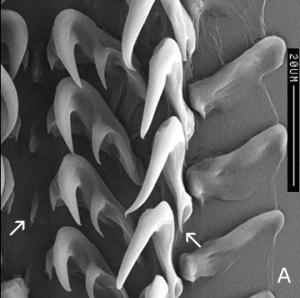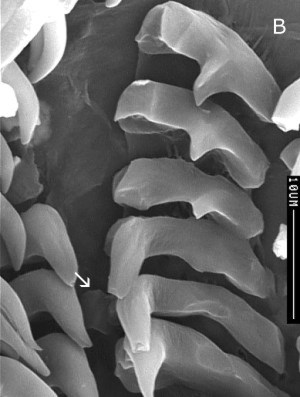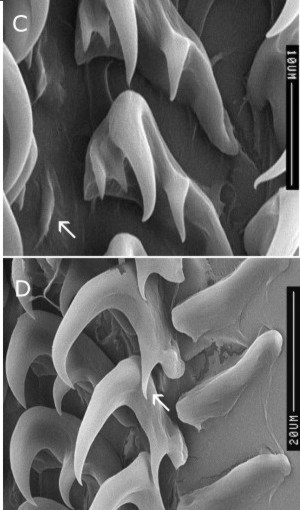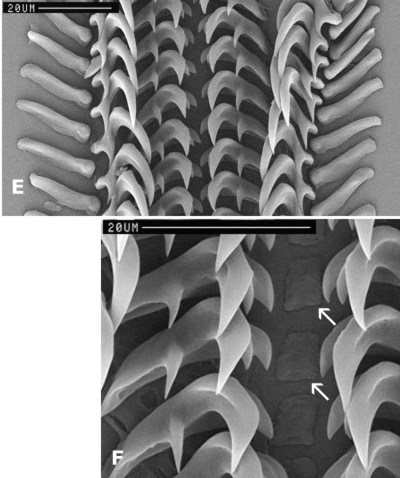Radulae from NW Pacific Vayssierea
May 16, 2000
From: Bill Rudman

Following Alexander Martynov's earlier message about Vayssierea from the northwest Pacific, he has sent me some specimens. Here are SEM photos of their radulae which show they are almost identical to the radula of the specimen of Vayssierea, already illustrated, from New Caledonia.
PHOTOS A-D: Anama Bay, Schikotan Is, Kurile Ids, 12-16m on Laminaria, 2, 2.5mm long preserved, AM C380204 [coll: E.F.Gurjanova].
PHOTOS E, F: Sobol Bay, Ussuri Bay, Peter the Great Bay, Sea of Japan. under intertidal rocks, 2, 3mm long preserved. AM C380203 [coll: A.V.Martynov].
SEM PHOTOS: Alison Miller.



PHOTO A: The Kurile Island animal has a small central tooth as in the New Caledonian (A - left arrow). The only point of difference is the small basal cusp on tooth 2 (A - right arrow).
PHOTO B: Central region at the old, worn end of the radula showing worn central tooth (arrow) and broken cuspless teeth 1.
PHOTO C: Central region at the new unused end of the radula showing central tooth and 4 cusps on tooth 1.
PHOTO D: outer view of tooth 2 showing basal cusp (arrow).
PHOTO E: section of whole radula of Ussuri Bay animal.
PHOTO F: central region showing plate-like central teeth (arrow).
There are two interesting features we can see in these NW Pacific animals. One is the shape of the central tooth, with a raised 'cusp' in the Kurile Ids specimens, but without this cusp in the Ussuri Bay specimens. The second is that all these NW Pacific specimens have a distinct basal cusp on tooth 2 which is not visble in the New Caledonian radula.
In preparing SEM mounts, the teeth are cleaned and then air dried before being given a gold coating. It is possible that this basal cusp, which is relatively thin and weak, could have collapsed on to the main shaft, in the New Caledonian specimen, and effectively 'disappeared' under a layer of gold. Unfortunately the SEM preparation of this specimen, has deteriorated and so I cannot re-examine it. However, if you look at PHOTO A above, you will see that the basal cusp is almost invisible in the second tooth from the top of the picture, so it is possible it was obscured in the New Caledonian specimen.
Interestingly if you look at the drawings I posted earlier, Baba (1937) draws this basal cusp in a Japanese specimen and Ralph (1944) records it from New Zealand, so it cannot be considered a feature unique to northern specimens.
My feeling at this stage is that any differences are intraspecific. What I will do now is collect some more specimens from eastern Australia and see what variation occurs within one population, and whether the basal cusp is present here.
Bill Rudman.
